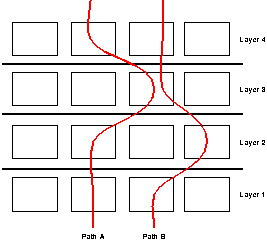
Layering is a fundamental structuring technique with a long history in system design. From early work on layered operating systems and network architectures [12, 32], to more recent advances in stackable systems [27, 15, 14, 26], layering has played a central role in managing complexity, isolating failure, and enhancing configurability. This paper describes a complementary, but equally fundamental structuring technique, which we call paths. Whereas layering is typically used to manage complexity, paths are applied to layered systems to improve their performance and to solve problems that require global context.
We begin by developing some intuition about paths. A path can be
viewed as a logical channel through a multi-layered system over which
I/O data flows, as illustrated in Figure 1. In this
way, a path is analogous to a virtual circuit that cuts through the
nodes of a packet-switched network. The only difference is that paths
are within a single host, while virtual circuits run between
hosts.

Also, the term ``path'' is well entrenched in our vocabulary. For example, we often refer to the ``fast path'' through a system, implying that the most commonly executed sequence of instructions have been optimized. As another example, we sometimes talk about optimizing the ``end-to-end path,'' meaning we are focused on the global performance of the system (e.g., from I/O source to sink), rather than on the local performance of a single component. As a final example, we sometimes distinguish between a system's ``control path'' and its ``data path,'' with the former being more relevant to latency and the latter more concerned with throughput.
Finally, paths can be loosely understood by considering specific OS mechanisms that have been proposed over the last few years. Consider the following examples.
The thesis of this paper is that these mechanisms are not isolated optimizations, but rather, that they can be unified and explained by the path abstraction. In a nutshell, these mechanisms all share the following fundamental idea: they expose and exploit non-local context.
Consider a layered system like the one illustrated in Figure 1. While the advantage of layering and modularity is to hide information, there are many situations when it would be beneficial for a given layer to have access to non-local context. For example, suppose one of the modules is processing an Ethernet packet. With only local context, the module knows nothing about the packet's relative importance compared to other packets. However, if it is known that the packet is part of a particular video stream, then it is easy to determine its processing deadline, what modules need to be executed to process it, how many CPU cycles this processing will require, where its data should be placed in memory, and so on. In other words, by knowing a certain set of invariants (e.g., that the packet is part of some video stream), the module is able to access and exploit global context that is available outside any one module or layer. Abstractly then, a path is defined by these invariants and provides access to the corresponding context.
Having access to non-local context leads to two kinds of advantages: (1) improved resource allocation and scheduling decisions, and (2) improved code quality. In the former case, work is segregated early, facilitating the following benefits:
In the latter case---improved code quality---the system has more information available to it, making more aggressive code optimizations possible. Examples of such optimizations include the following:
This paper makes two contributions. First, it develops an explicit path abstraction; Section 2 explores the design space for paths, and Section 3 describes an implementation of paths in the Scout operating system. Second, the paper demonstrates how having a path abstraction leads to the first set of advantages outlined above, i.e., those that have to do with improvements in resource allocation and scheduling. In particular, Section 4 describes an application that receives MPEG-compressed video over a network and then decodes and displays it. A companion paper demonstrates some of the code-related improvements attributable to paths [23].